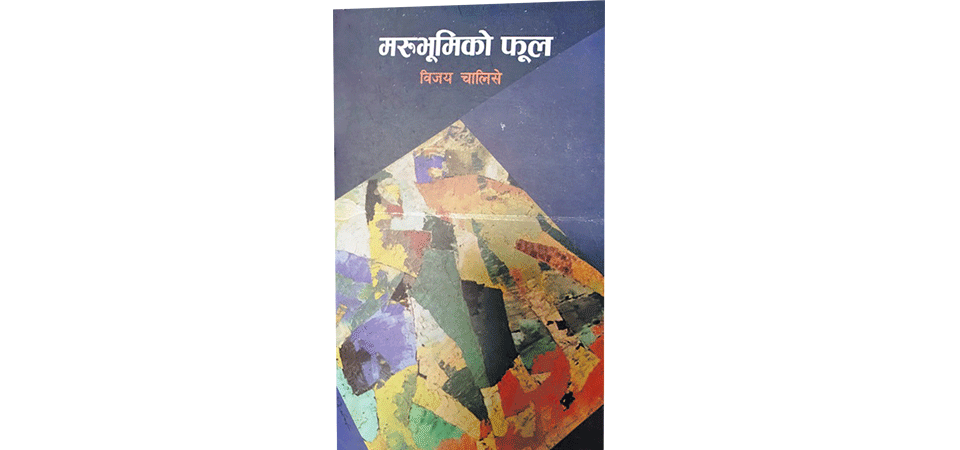Interesting Travelogue, Memoir Essays

Gandhi Raj Kafle
We can call the under-reviewed literary book entitled “Marubhumiko Phul” (Flower of Desert) a travelogue plus memoir. Author Vijaya Chalise, who already has three books of travelogue essays published to his credit, has once again presented some of his cherished memoirs into the pieces of travelogue writings. It is a two-part book: In one part there are eight travelogue essays and in part two there are twelve memoir essays.
The “Marubhumiko Phul” (the Flower of Desert) is a travelogue essay, which details the author’s visit to the beautiful place of Mount Abu in the Rajasthan State of India. This is an interesting description, where the author has succeeded to utilise his imaginative liberty with the actual beauty of nature in course of his visit to the place.
However what should also be said is it is not only the Marubhumiko Phul, where he has been impressive in the description; he is up to the mark in the other seven travelogue pieces, too. The first essay in this book is Shreebhawar Lekama Mrityusparsh (Near Death Experience at Shreebhawar Lek) and it is a live presentation of the author’s travel to the geographically difficult place of Nepal’s Western mountainous region of Bajhang and Baitadi Disctrict’s dreadful Shri Bhanwar Lek.
The genre travelogue writing always puts authors at ease in the presentation of literary ideas: They flow with sentiments more than facts and readers move with the beauty of their description. The eight travelogue pieces of author Chalise in this book are beautifully woven with the thought and power of literary art.
In part travelogue, the author has included three pieces related to his foreign trips – one is about Mount Abu and its surroundings, the second is the beautiful city of Lahore of Pakistan and the third and the last one is about the war-devastated place of Hiroshima in Japan. These are world-famous places; all of them have plenty of messages to learn about for mankind and the author has nicely explained the value of these messages in the art of travelogue writing.
The descriptive connectivity of Lahore, which the author has attached in his description for the Nepali readers, is all-time interesting because it helps to know about much listened and deeply spelt Nepali word of ‘Lahure’. The word ‘Lahure’ has a specific meaning because in World War times the Nepali youths wishing to go for military recruitment had to go to Lahore for training. Thus, all Lahore visitor Nepali youths, who got training there and deployed on different battlefields for military purposes in the wars, began to be called ‘Lahure’.
Later, even when the World Wars were over and no one now needed to go to Lahore for this purpose; the Nepali word of ‘Lahure’ continues to live in the lips of Nepali society. Yet, the fact is a fact; it is better to know than not to know and a juicy description of Chalise about the beautiful city of Lahore in Pakistan will certainly be valuable for readers of literature.
The beauty of a travelogue piece of writing takes height with the depth of the author's feelings and facts and it is that feature, which provides attractive support to the imagination of the writer. Author Chalise is not only imaginative here; he has been skilful to play with information and facts in these travelogue pieces.
Similarly, let’s talk about the second part also. It is the section of memoir essays. The author should have prepared a separate publication for this instead of publishing it in a single book and his long experience of life and literature could have been good inputs for this purpose. Yet, it seems, the memoir pieces, which Chalise has included in the “Marubhumiko Phul”, too are relevant and useful. It seems he has been selective to give space to his writings in this section.
The point to admit, thus, is that the author has some unforgettable moments of life in the past and he has given due value through the medium of memoir essays in part two of this book.
In addition to it, Chalise’s these essays also briefly tell about how his interest and talent to become an author deepened and sharpened. This is interesting to read also to aspiring authors of Nepali literature.
Conclusively, what must be said is all authors have their roots and they value this identity. Chalise as an author, too, has been the same in this book because he has fondly remembered his birth and childhood places like Arubari, Bouddha, Chabahil and the respected place of the Gorkhapatra where he worked in the different capacity over three decades in the past. It is a nice literary piece, which has come out during the troublesome time of the Pandemic coronavirus. Kudos to the author!
Recent News

Do not make expressions casting dout on election: EC
14 Apr, 2022
CM Bhatta says may New Year 2079 BS inspire positive thinking
14 Apr, 2022
Three new cases, 44 recoveries in 24 hours
14 Apr, 2022
689 climbers of 84 teams so far acquire permits for climbing various peaks this spring season
14 Apr, 2022
How the rising cost of living crisis is impacting Nepal
14 Apr, 2022
US military confirms an interstellar meteor collided with Earth
14 Apr, 2022
Valneva Covid vaccine approved for use in UK
14 Apr, 2022
Chair Prachanda highlights need of unity among Maoist, Communist forces
14 Apr, 2022
Ranbir Kapoor and Alia Bhatt: Bollywood toasts star couple on wedding
14 Apr, 2022
President Bhandari confers decorations (Photo Feature)
14 Apr, 2022










